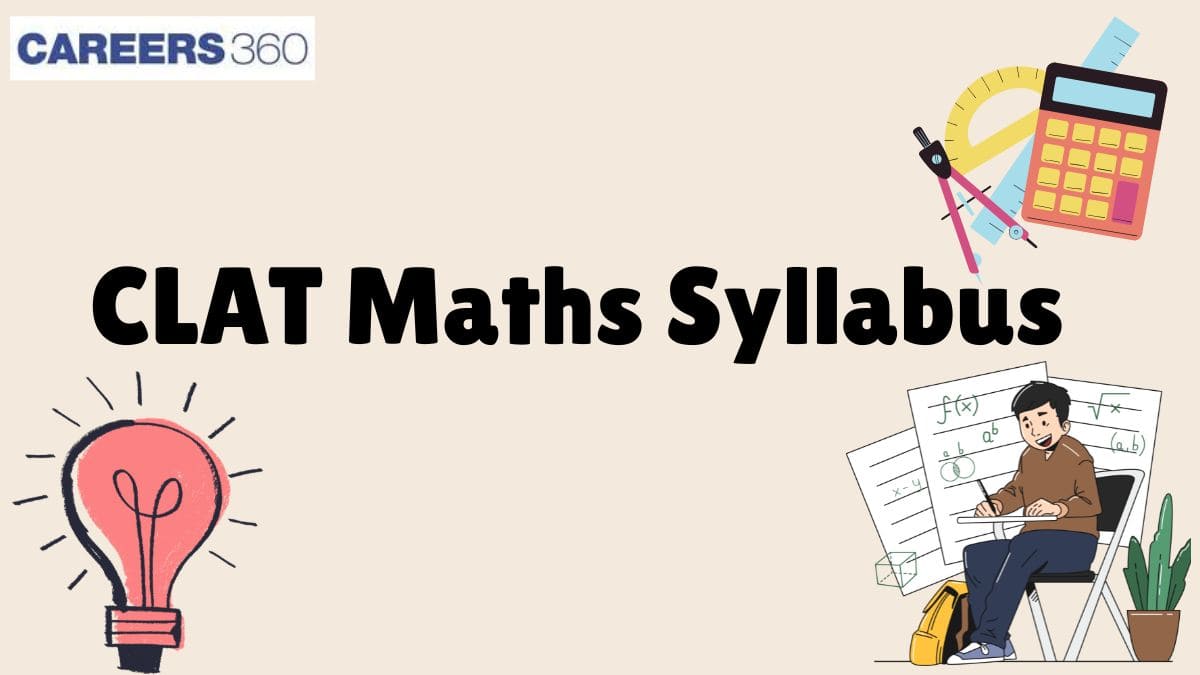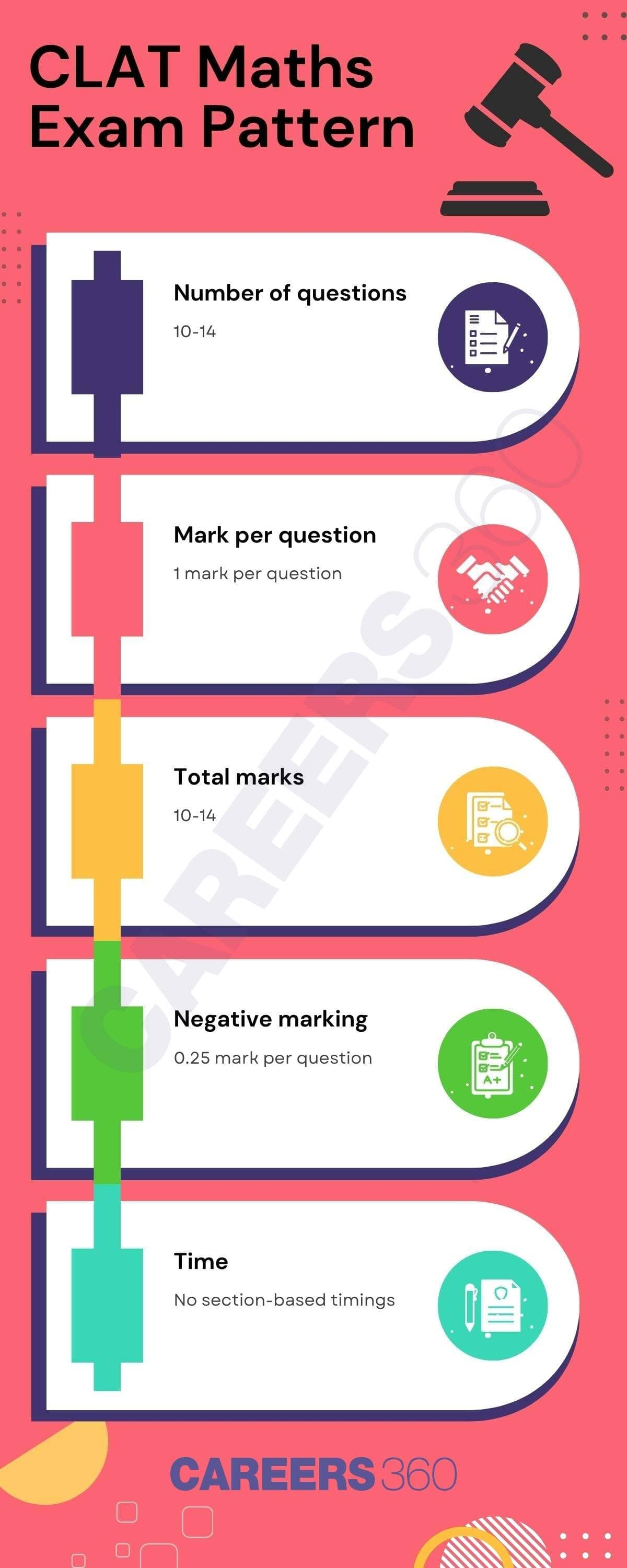UPES Integrated LLB Admissions 2026
Ranked #18 amongst Institutions in India by NIRF | Ranked #1 in India for Academic Reputation by QS Rankings | 16 LPA Highest CTC
CLAT Maths Syllabus 2026: The Consortium of NLUs (CNLUs) prescribes the CLAT Maths 2026 syllabus on its official website - consortiumofnlus.ac.in. The CLAT quantitative techniques syllabus 2026 will have a 10% weightage in the CLAT 2026. The quantitative techniques section will feature short sets of facts or textual/ numerical data, followed by questions requiring basic mathematical application. The maximum difficulty level of the CLAT maths syllabus 2026 is of class 10th grade, which includes mathematical concepts such as ratios, proportions, mensuration, algebra, and statistical estimation. This section tests the candidate’s ability to reason with numbers and apply quantitative logic, an important skill in evidence-based legal analysis. Read on to find out all the details on the syllabus of CLAT Maths 2026, including important topics, preparation tips and more.
The steps to download the CLAT 2026 result is given below.
This Story also Contains

Download: CLAT Maths Syllabus 2026 PDF
The CLAT syllabus for maths carries the least weightage in the CLAT 2026 syllabus. However, it is a tricky section which can make a big difference in the overall CLAT score. Preparing well for the CLAT Maths 2026 syllabus can enable the candidates to clear the CLAT cut offs for top NLUs. The Common Law Admission Test will be conducted on December 7, 2025, in offline mode.
Particulars | Details |
|---|---|
Weight | 10% |
Type of questions | MCQs |
Number of questions | 10-14 |
Skills tested | Working with numerical data and performing class 10 mathematical operations. |
The CLAT quantitative techniques syllabus 2026 requires the candidate to work with numerical data and derive appropriate inferences and conclusions. There will be 2-4 passages which contain short sets of facts or propositions, or other numerical information presented in textual form. The passages will then be followed by objective questions based on the data given in the passage.
In order to answer the questions in the CLAT Maths syllabus 2026, candidates may have to perform arithmetic operations, manipulations, and derive inferences. Candidates may also have to apply mathematical operations of up to the class 10 level to solve the questions.
Basic Arithmetic: Basic mathematical operations such as addition, subtraction, division and multiplication.
Ratios and Proportions: Calculating the percentage increase or decrease and relationship between given variables. Includes working with fractions.
Basic Algebra: Algebraic operations of a class 10 level
Mensuration: Includes topics on measurements, volume and geometry
Statistical Estimation: Making interpretations about the various possible results from a given set of data.
Profit and Loss: Calculating the gains made and losses incurred on buying and selling.
Time and Work: Problems in calculating the work completed and the days required to complete the work by a given number of workers
Speed, Time and Distance: Calculating one among the three variables of speed, time and distance when two others are given.
Probability: Calculating the possible chances of occurrence of a particular outcome
The CLAT 2026 quantitative techniques section will have 10-14 multiple-choice questions. Each question carries 1 mark. There is also a negative marking of 0.25 marks for every wrong answer.
Particulars | Details |
|---|---|
Number of questions | 10-14 |
Total marks | 10-14 |
Marks per question | 1 |
Negative marking | 0.25 mark for every wrong answer |

| Year | Section Details | Difficulty level |
|---|---|---|
| 2021 | Questions on simplifications, profit and loss, income and expenditure, percentages, ratios, and average | Moderate |
| 2022 | 2 questions from ratio and proportion, and one from percentage | Easy |
| 2023 | 3 sets of passages with 15 questions in total | Easy to moderate |
| 2024 | 2 passages with 12 CLAT Maths questions on topics such as arithmetic, ratio and proportion. | Easy to moderate |
| 2025 | 2 passages with 12 questions on topics like budget, profit and loss, interest, income and expenditure, percentages, ratios, and average | Easy to moderate |
You may also check -
The CLAT 2026 maths syllabus can be tough for students who are not from the science stream. However, it is important to understand that the difficulty level of the CLAT maths questions is not greater than Class 10th. Candidates to have elementary knowledge of mathematics and some class 10 mathematical concepts from algebra and mensuration. The 10% marks in the CLAT maths syllabus 2026 can help well-prepared candidates outperform others and get a good score in CLAT that is well above the cut off for top NLUs.
The CLAT 2026 is open for candidates from non-science and non-mathematics backgrounds as well. So, preparing with a special focus on the CLAT maths syllabus 2026 can give candidates a competitive advantage over others in the exam. Given below are a few tips on preparing for the CLAT 2026 quantitative techniques that aspirants can make use of.
Candidates must work on developing a good theoretical understanding of the concepts covered in the CLAT maths syllabus. They can refer to good mathematics books to build a good foundation in the topics.
The theoretical understanding must be complemented with a practical approach by repeatedly solving problems that are based on the underlying mathematical concepts. Maths is learnt more by doing than only reading.
The third tip to do well in CLAT quantitative techniques is to apply mathematics in everyday life. Aspirants must resort to performing manual calculations instead of using a calculator to boost calculation speed.
Solving CLAT 2026 sample papers can make candidates comfortable with the CLAT Maths 2026 paper pattern. It can also let them know where they stand in terms of the level of preparation.
Candidates must practise speed reading to improve reading and comprehension speed and save time during the exam. The CLAT Maths questions will be in the form of a short set of textual passages followed by question.
You may also check - CLAT Maths Questions with Solutions
Given below is a list of books for CLAT Maths 2026 with which candidates can prepare for the CLAT 2026 mathematics syllabus.
Sr No. | Book Name |
|---|---|
1 | Quantitative Aptitude by RS Aggarwal |
2 | Fast Track Objective Arithmetic by Arihant Publications |
3 | Elementary Mathematics with Numerical Ability by Prateek Jain |
4 | Quantitative Aptitude for Competitive Examinations by Pearson's |
5 | Class 10 NCERT Maths textbook |
You may also check -
| Commercial Law | Civil Law |
| Comparative Law | Consumer Law |
| Constitutional and Administrative Law | Business Law |
| Corporate Law | Banking Law |
| Criminology and Forensic Law | International Trade Law |
Frequently Asked Questions (FAQs)
The level of Maths in CLAT is of class 10 difficulty level.
The CLAT Maths syllabus 2026 may come across as difficult for students from a non-science background. The CLAT Maths section tests the basic elementary mathematics required up to class 10 and requires constant practice to improve solving speed.
In CLAT Maths 2026, there will be 10-14 questions.
On Question asked by student community
Hello,
With a score of 82 in CLAT 2026 under the EWS category, you do have a chance at getting into decent NLUs, but it may depend on the specific NLU and the cut-offs for this year.
Generally:
Top NLUs (like NLSIU, NALSAR, NUJS, WBNUJS) usually have higher cut-offs, so 82 might be below their usual EWS opening rank.
Mid-tier NLUs (like HNLU, GNLU, RMLNLU, NLUJ) could be within reach.
Lower-ranked NLUs and state NLUs are more likely to accept your score.
Your best step is to check the previous years’ EWS cut-offs for each NLU to see where your rank might fit.
Hope it helps !
Hello,
NUJS is among the top tier law colleges in the country. A high score in CLAT is required to get into NUJS. For you, getting into NUJS is possible but challenging. The cut off for general category often is very high (+90), but you WB domicile improves your chances for admission. Keep an eye on the final rank list and cut off.
Thank you.
Hello
With a score of 91.5 in CLAT UG 2026, your expected All India Rank would likely fall somewhere around AIR 500 to 1,000, based on previous years’ trends. The exact rank can shift depending on how tough the paper was and how other students performed. Since you belong to the OBC category, your category rank will be even better. This score definitely keeps you in a competitive range for several NLUs.
Hello,
CLAT or Common Law Admission Test is conducted for admission to top tier law colleges in India. The exam is conducted by Consortium of National Law Universities. While NLU's are generally not available for admission at this rank but there are many private colleges which offer good legal education and placements. JINDAL, UPES, Amity Law School, Lovely Professional University, IFIM Law School, Alliance University and many more. For more information you can check out the official website of Careers360.
https://law.careers360.com/articles/top-colleges-other-nlus-accepting-clat-scores
Thank you.
If you are expecting around 80 marks in CLAT 2026, your chances will mainly depend on that year’s overall difficulty level and how the marks translate into ranks. In most years, a score around 80 usually places candidates somewhere in the mid-rank range, which means that the top NLUs like NLSIU Bengaluru, NALSAR Hyderabad or WBNUJS Kolkata are generally difficult to get at this score. However, some of the newer or mid-tier NLUs may still be possible depending on cut-offs, reservation category, and seat availability during later rounds. Students with similar scores in past years have sometimes received calls from NLUs such as NLU Jabalpur, NLU Assam, NLU Tripura, NLU Aurangabad, or NLU Shimla, but the exact possibilities shift every year. Treat this score as competitive but not in the top bracket, and wait for the official ranks to get a clearer picture of which options are realistically open. All the best!
Among top 100 Universities Globally in the Times Higher Education (THE) Interdisciplinary Science Rankings 2026
Integrated Learning – A balanced blend of management and legal education
Ranked #18 amongst Institutions in India by NIRF | Ranked #1 in India for Academic Reputation by QS Rankings | 16 LPA Highest CTC
Last Date to Apply: 21st December 2025 | Grade 'A+' accredited by NAAC | Ranked 33rd by NIRF 2025
Approved by BCI | Continuous interaction with leading experts from the industry | Global Exposure
Admissions open for B.A. LL.B. (Hons.), B.B.A. LL.B. (Hons.) and LL.B Program (3 Years) | School of Law, MRU ranked No. 1 in Law Schools of Excellence in India by GHRDC (2023)